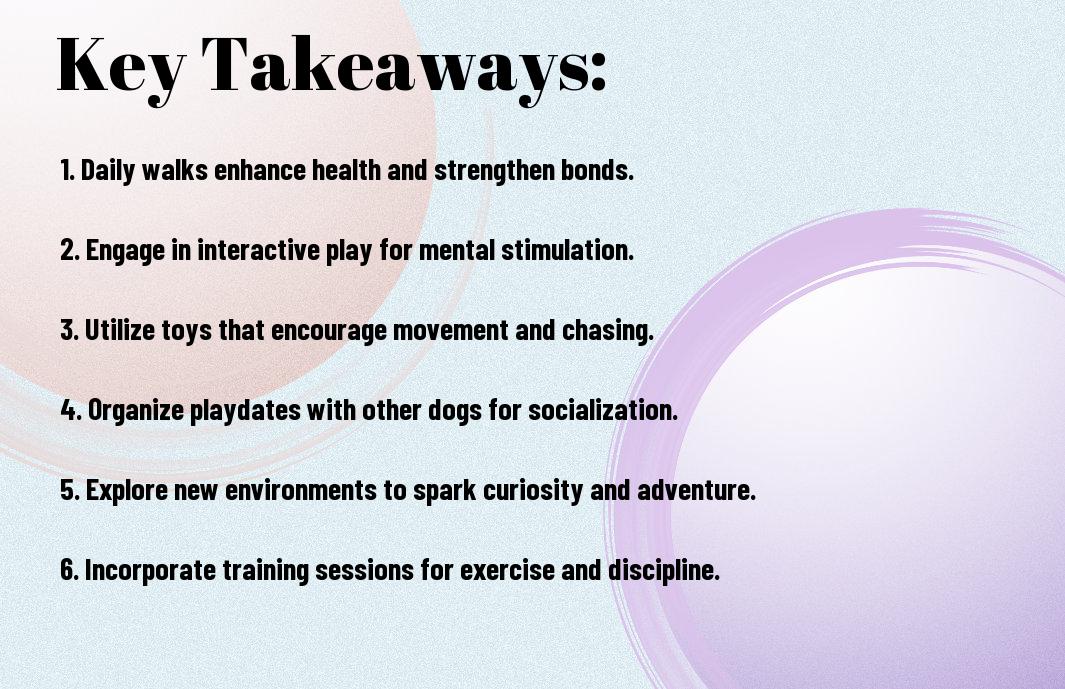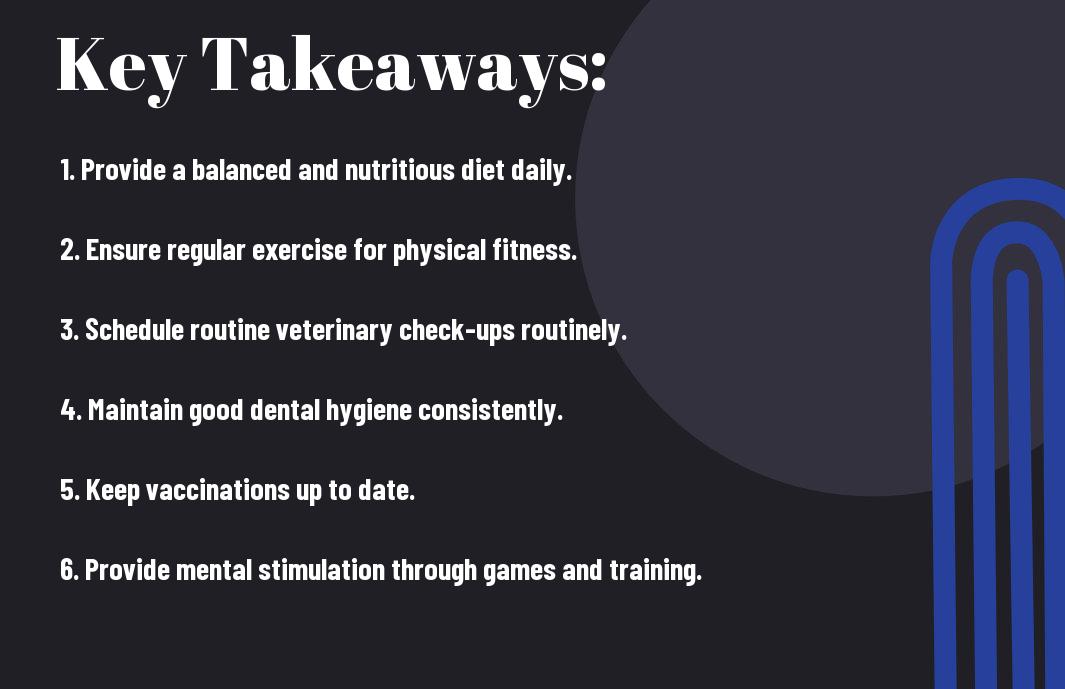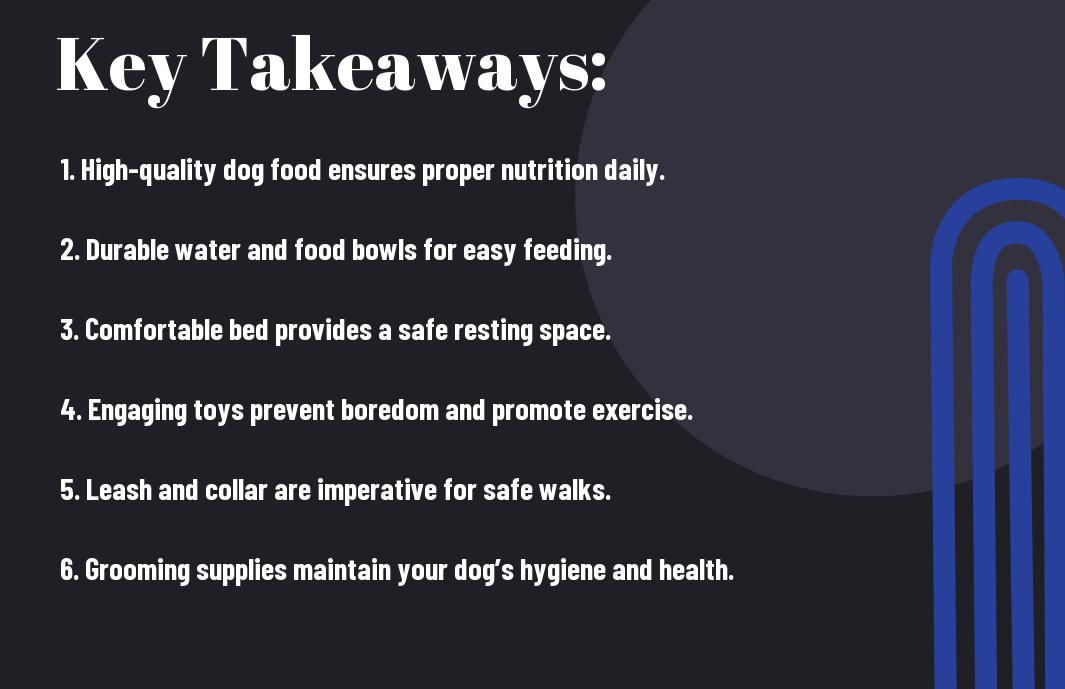There’s a growing awareness of the importance of keeping your dog active and fit for their overall health and happiness. As a responsible pet owner, you play a vital role in ensuring your furry friend remains energetic and engaged. From daily walks to interactive playtime, there are simple yet effective strategies you can implement to promote a healthy lifestyle for your dog. In this post, we’ll explore practical tips that you can easily incorporate into your routine to boost your dog’s physical activity and well-being.


Understanding Your Dog’s Fitness Needs
Before you can create an effective fitness plan for your dog, it’s crucial to understand their unique fitness needs. Each dog is an individual, and their exercise requirements can vary widely based on several factors such as age, breed, health status, and energy level. By gaining insight into these aspects, you can tailor activities that will keep your dog healthy and engaged, preventing obesity and promoting a longer, happier life.
Importance of Regular Exercise
Around the world, dog owners recognize that regular exercise is not just about keeping your dog fit; it plays an crucial role in their mental well-being as well. Engaging in physical activities helps prevent behavioral issues such as anxiety, boredom, and destructive tendencies. When dogs have a chance to expend their energy through regular workouts, they’re less likely to take that energy out on your furniture or shoes.
Additionally, consistent exercise can enhance your dog’s overall health. It strengthens their muscles and joints and can help keep their weight in check. An active dog is a happy dog, and incorporating regular movement into their routine can lead to healthier habits that both you and your furry friend can enjoy together.
Different Breeds and Their Activity Levels
Around the world of dog breeds, you will find a diverse range of activity levels. For instance, a Border Collie or Siberian Husky generally has higher energy requirements and thrives on vigorous activity. In contrast, breeds like the Bulldog or Basset Hound are generally more low-energy and may not need as much physical exertion. Understanding your dog’s breed characteristics can inform your approach to their exercise routine, ensuring that they are neither overworked nor under-stimulated.
Another point to consider is that age and individual personality can also influence your dog’s activity level. While some older dogs might still enjoy shorter walks, younger dogs are typically more energetic and require longer outdoor playtime. By recognizing the nuances of your dog’s breed and personal traits, you can create a balanced fitness plan that caters specifically to their needs.
Recognizing Signs of Being Overweight
Regular observation is key when it comes to recognizing signs that your dog may be overweight. Look for a noticeable lack of definition in their waistline and difficulty in feeling their ribs. A healthy dog should have a discernible waist and not appear to be round or stocky when viewed from above. If your dog seems sluggish during play or has trouble keeping up on walks, these may be signs that they need more exercise and a closer look at their diet.
Additionally, your veterinarian can provide valuable insights during routine check-ups. They can help you assess your dog’s weight and recommend tailored advice on diet and activity that fits your dog’s specific health needs. Staying proactive about your dog’s weight prevents health conditions and ensures they live a vibrant, full life.
Fitness is not just a physical endeavor but also a commitment to your dog’s overall well-being. Regular exercise contributes to healthy weight management and lowers the risk of obesity-related diseases. If you pay attention to their needs and adapt their fitness plans accordingly, you support their journey towards vitality and happiness.
Daily Exercise Routines
Any dog owner knows that keeping your furry friend active is important for their health and happiness. Daily exercise routines play a vital role in maintaining a fit and energetic dog. By incorporating a variety of activities into your dog’s daily routine, you can prevent boredom and ensure they receive the physical stimulation they need. From walks to swimming, there are many ways you can make sure your dog stays fit and healthy.
Walks: The Basic Everyday Exercise
Between the hustle and bustle of daily life, walks serve as the foundational exercise for most dogs. A simple stroll around the neighborhood or local park not only keeps your dog physically active, but it also provides mental stimulation through exposure to different scents, sights, and sounds. A daily walk typically ranges in duration from 20 minutes to an hour, depending on your dog’s age, size, and energy levels. This simple routine can significantly enhance your pet’s well-being and strengthen the bond you share.
Adding variety to your walking route or time can keep things exciting for both you and your dog. You can explore different trails or parks, change the pace with intervals of jogging, or even invite other dog owners for a social stroll. Engaging in these walks not just benefits your dog’s physical health but can also contribute to their emotional well-being, reducing anxiety and promoting happiness.
Fetch: A Fun Way to Engage
To ensure your dog remains active, fetch is a great game that never gets old. Not only does it get your dog moving, but it also allows you to tap into their natural instincts to chase and retrieve. You can start in your backyard, throwing a toy or ball and encouraging your dog to bring it back to you. This fun activity helps to improve agility and coordination while strengthening your bond through interactive playtime.
Incorporating variations of fetch can keep your dog on their toes—experiment with different toys or trying it in various environments, such as at the beach or park. If your dog enjoys running, you can even take the game up a notch by throwing the toy farther or introducing a challenge, like having them navigate hurdles before they retrieve. Engaging your dog in fetch not only promotes physical activity but also stimulates their mind, leading to a well-rounded, happy pet.
Swimming: A Low-Impact Activity
An excellent addition to your dog’s exercise repertoire is swimming, which is particularly beneficial for dogs with joint issues or those who are older. As a low-impact activity, swimming allows your dog to engage in an energetic workout without the strain that can come from running or jumping. This makes it an ideal exercise for maintaining cardiovascular health while being gentle on their joints. Depending on the location, you can take your dog to a lake, beach, or even a dog-friendly pool that allows them to splash around and enjoy the water.
Swimming can build muscle tone, stamina, and coordination, all while allowing your dog to have fun. You can also incorporate fetch while swimming by throwing toys into the water, making it a more enjoyable and interactive experience. Make sure to always keep a close eye on your dog during swimming sessions to ensure they are safe and comfortable.
LowImpact activities like swimming provide a wonderful alternative to high-intensity workouts, promoting fitness without excessive wear and tear on your dog’s body. It’s a great way to ensure that your dog stays active while offering a refreshing and enjoyable experience during warm days. With the right approach, your dog will thrive in both health and happiness.
Mental Stimulation for Physical Fitness
All dog owners know that keeping your dog healthy and active goes beyond just physical exercise. Engaging your dog mentally can contribute significantly to their overall fitness and well-being. By providing mental challenges, you help prevent boredom, reduce anxiety, and promote a more positive behavior, which in turn can lead to a happier, healthier dog.
Puzzle Toys and Interactive Games
Physical exercise can be complemented with puzzle toys and interactive games designed to stimulate your dog’s mind. These toys often engage your dog in problem-solving and require them to think critically to access treats or toys hidden within. This form of mental exercise not only keeps your dog entertained but also challenges their cognitive abilities, which is just as important as physical activity.
Incorporating puzzle toys into your dog’s routine can also increase their interest in playtime. You might find that your dog approaches activity with more enthusiasm when it involves a stimulating toy that rewards them for their efforts. This combination of mental and physical engagement keeps your dog both fit and happy.
Training Sessions as a Form of Exercise
Above all, training sessions can serve as an effective way to exercise your dog while reinforcing good behavior. When you teach your dog new commands or tasks, you’re not only stimulating their mind but also incorporating physical movement through actions like sit, stay, or come. The combination of mental engagement and physical activity can lead to a well-rounded exercise session that benefits both you and your dog.
But it’s important to approach training with patience and creativity. Incorporate treats or toys to enhance motivation, and make the sessions feel like more of a game than a chore. By varying the commands and increasing difficulty, you keep your dog engaged and eager for more, ensuring that both their mind and body stay active.
Scent Work: Engaging Your Dog’s Nose
Above all, teaching your dog to participate in scent work can be a fantastic way to provide them with mental and physical stimulation. Dogs have an incredible sense of smell, and utilizing this ability can turn everyday walks into exciting adventures. Set up fun scavenger hunts in your yard or around your home, hiding treats or favorite toys for your dog to find using their nose.
And not only does scent work keep your dog physically active as they search for hidden items, but it also taps into their natural instincts, making them feel fulfilled and happy. As you engage in scent work together, you’ll likely strengthen the bond you share with your furry friend and improve their behavior and focus over time.
Outdoor Adventures
To keep your dog active and fit, outdoor adventures provide fantastic opportunities for exercise and bonding. From hiking through scenic trails to enjoying a playful day at the park, these activities can make a significant difference in your dog’s physical and mental well-being. Exploring the great outdoors not only keeps your furry friend active, but it also allows you both to appreciate nature, which can lead to a happier and healthier lifestyle.
Hiking: Exploring Nature Together
Among the many outdoor adventures you can commence on, hiking stands out as a phenomenal way to challenge not just your dog’s stamina but your own as well. Hiking can be an excellent cardiovascular workout, and depending on the route you choose, it can engage your dog’s muscles as they navigate different terrains. Whether you’re traversing a gentle slope or tackling a more rugged trail, both you and your pup will enjoy the fresh air, the scenic views, and the invigorating sense of exploration.
As you hike, your dog will have the chance to stimulate their senses with all the various sights, sounds, and smells that nature has to offer. Remember to choose trails suitable for your dog’s fitness level, ensuring a positive experience for you both. Don’t forget to bring plenty of water and take breaks as needed, allowing your dog to rest and indulge in new scents along the way.
Dog Parks: Socialization and Play
After a refreshing hike, dog parks serve as another fantastic venue for keeping your dog active. These spaces allow your dog to socialize with other dogs, promoting not just physical exercise but also vital social skills. Interacting with other canines is vital for your dog’s emotional well-being, helping them learn proper play behavior while strengthening their resilience and confidence.
Additionally, dog parks often offer a variety of activities to keep your pet engaged, from agility features to open areas where they can run freely. You’ll find that these parks provide a welcoming environment for your furry friend to let loose, burn off excess energy, and make new friends—both canine and human. Establishing a regular routine of visiting dog parks can lead to significant benefits in your dog’s physical fitness while enhancing their overall happiness.
It’s vital to choose a dog park that aligns with your dog’s play style and temperament. Look for parks that are well-maintained and where dog owners are vigilant, ensuring a safe environment for everyone. Observing your dog’s interactions with other dogs will also help you gauge if your pet enjoys the social atmosphere or prefers a more solitary setting.
Agility Courses: Building Strength and Agility
One exciting way to keep your dog fit and engaged is by introducing them to agility courses. These courses not only provide physical exercise but also enhance your dog’s coordination and mental sharpness as they navigate through various obstacles, such as jumps, tunnels, and weave poles. Working through an agility course can be a fun and rewarding activity for both you and your dog, encouraging teamwork and communication between the two of you.
As you practice agility exercises together, you’ll notice improvements in your dog’s strength and agility, contributing to their overall fitness. It’s also an excellent opportunity for positive reinforcement training, helping you to build a stronger bond with your pet while instilling discipline and focus. Following your dog’s progress and celebrating milestones will keep them motivated while also improving their overall athleticism.
Together, you can create a training routine that fits your schedule and your dog’s abilities. Setting achievable goals and gradually increasing the difficulty of the agility course will ensure that your dog stays challenged and enthusiastic about their participation. Engaging in such activities fulfills your dog’s physical needs while strengthening the bond between you two, making it a win-win situation.

Seasonal Activities
Keep your dog engaged and healthy throughout the year by participating in seasonal activities that cater to their natural instincts and energy levels. Different seasons offer unique opportunities to explore new games and adventures that can help maintain your pet’s fitness while also strengthening your bond. Whether you prefer outdoor fun in the sun or cozy indoor play during rainy days, there are plenty of ways to keep your furry friend active all year long.
Summer Fun: Water Games and Beyond
With the warm temperatures of summer, it’s the perfect time to incorporate water games into your dog’s routine. Many dogs love swimming, so consider taking your pet to a dog-friendly beach or lake. Not only will this provide them with a refreshing escape from the heat, but it also gives you an excellent opportunity for exercise as you throw a ball, frisbee, or even seashells into the water for them to retrieve. If you don’t have access to natural bodies of water, a kiddie pool in your backyard can be a great alternative to keep your dog entertained and cool.
In addition to swimming, summer afternoons can be spent engaging in activities such as hiking, agility training, or playing fetch in the park. Keeping your dog active during these sun-filled days is crucial for their physical health and mental stimulation. Just make sure to provide plenty of water breaks and never leave your dog outside during the hottest parts of the day.
Winter Play: Safe Snow Activities
Above all, winter should not signal the end of outdoor activities for your dog. Snow gives you the chance to engage in playful games that utilize your dog’s energy while keeping them fit. In well-trodden, safe areas, consider playing in the snow with activities like fetch, or even building a snow maze for your dog to navigate. These activities promote physical exercise and encourage your pet to have fun while also allowing you to enjoy the beauty of winter scenery together.
Even though winter presents challenges such as cold temperatures and slippery surfaces, you can adapt your outdoor activities to ensure your dog’s safety. Always ensure your dog is wearing appropriate gear, such as a warm coat or booties if they have sensitive paws. Additionally, be mindful of your dog’s limits; not all dogs are made to withstand very low temperatures, so keep play sessions shorter and monitor their behavior closely.
Indoor Exercise During Inclement Weather
At times, inclement weather can put a damper on your outdoor plans, but that doesn’t mean your dog has to miss out on important exercise. Indoor play is a fantastic way to keep your dog active and stimulated when it’s too rainy or snowy outside. You can transform your living space into an engaging activity area by incorporating games such as hide-and-seek, tug-of-war, or obstacle courses created using furniture and toys. These games not only benefit physical health but also challenge your dog’s mind.
A great way to make the most of indoor exercise is to vary activities to keep things fresh and exciting. Consider investing in toys that challenge your dog mentally, such as puzzle feeders or interactive toys that dispel treats. This variation prevents boredom and keeps your dog engaged, leading to a healthier and happier companion even when you can’t step outside. By being creative with your indoor exercises, you can ensure your dog remains fit and entertained throughout the year.
Creating a Fitness Plan
Once again, it’s vital to approach your dog’s fitness with a structured plan. Tailoring a fitness regimen that suits your dog’s age, breed, and energy level is important for long-term success and well-being. The first step is to break down your goals into manageable chunks that are achievable for both you and your furry friend, ensuring it remains an enjoyable process. By creating a schedule that incorporates a variety of activities, you’ll keep your dog engaged and motivated to stay active.
Setting Realistic Goals
Along your journey to keep your dog active, setting realistic goals is key. For instance, if you have a senior dog who has limited mobility, a target of a 30-minute hike may not be feasible initially. Instead, you could aim for shorter, more frequent walks, gradually increasing the duration and intensity as your dog builds stamina. Assess your dog’s abilities and create specific, measurable, attainable, relevant, and time-bound (SMART) goals that reflect both of your capabilities.
By setting appropriate benchmarks, you foster a sense of achievement in both yourself and your dog. This positive reinforcement can be motivating, making fitness a shared goal that enhances your bond. Aim to reassess and adjust these goals as your dog progresses, taking into account their response to the activities you’ve planned together.
Tracking Progress and Adjustments
Across your fitness journey, tracking progress is important for making necessary adjustments. Maintaining a log of your dog’s activities, including types of exercises, durations, and how they responded, will give you valuable insights into what works best. This record can help you identify patterns, such as whether your dog prefers longer walks on certain days or enjoys games of fetch more than agility workouts. By paying attention to these details, you can tailor your workout plan to meet their needs effectively.
Considering this, it’s also important to adjust plans based on your dog’s health and energy levels. Just like humans, dogs can have off days or require breaks. Be attentive to any signs of fatigue or discomfort, and feel free to modify your fitness plan accordingly. Regular check-ins with your veterinarian can also provide guidance, ensuring your dog’s fitness plan aligns with their overall health.
Involving the Whole Family in Activities
Whole family involvement can make fitness activities more enjoyable for both you and your dog. Engaging your family members in walks, runs, or even playing games with your dog not only keeps your pet active but also fosters a sense of teamwork. Whether it’s organizing a family day at the park or scheduling daily walks together, you will create an enriching environment that promotes fitness for everyone involved.
Plan activities that cater to everyone’s interests and physical capabilities. Not everyone may enjoy the same outdoor activities, so consider mixing it up—some family members might prefer jogging, while others may enjoy leisurely strolls or hiking. Including your dog in these activities will not only help maintain fitness levels but also strengthen familial bonds through shared experiences and responsibilities.
Conclusion
With this in mind, keeping your dog active and fit doesn’t have to be a daunting task. Simple activities such as daily walks, playful fetch sessions, and engaging puzzle toys can significantly enhance your pet’s physical and mental well-being. By incorporating these easy-to-follow methods into your routine, not only can you help your dog maintain a healthy weight, but you will also strengthen the bond you share through shared activities and adventures. Prioritizing fitness for your dog benefits both their happiness and longevity.
Additionally, being creative with the ways you provide exercise can bring excitement to your dog’s day. Consider exploring new trails together, participating in dog-friendly community events, or even setting up a safe play area in your backyard. By consistently integrating these fun activities into your lives, you can foster a lifestyle that promotes overall health for your canine companion while enjoying the many benefits that an active lifestyle can offer. Your proactive approach to your dog’s fitness will lead to a happier, healthier life for both of you.
Q: What are some easy exercises I can do with my dog to keep them fit?
A: There are plenty of enjoyable activities you can engage in with your dog. Walking or jogging is a classic option that can easily be adapted to suit both your fitness levels and your dog’s breed. Playing fetch is another great exercise that stimulates both your dog’s mind and body. You might also consider setting up a small obstacle course in your backyard with hurdles or tunnels to challenge their agility. Swimming is another fantastic low-impact option for dogs that enjoy water. Choose activities that fit into your routine and your dog’s personality to ensure they stay active and engaged.
Q: How often should I be exercising my dog to maintain their health?
A: The frequency of exercise for your dog can depend on various factors, including their age, breed, and overall health. A good rule of thumb is to aim for at least 30 minutes to two hours of exercise each day, divided into multiple sessions if needed. Puppies and highly energetic breeds may require more activity, while older or less active dogs might need shorter, gentler walks. Pay attention to your dog’s energy levels and adjust their routine accordingly to find the right balance for their well-being.
Q: Are there specific toys or activities that can help keep my dog active indoors?
A: Absolutely! If outdoor play isn’t feasible, there are several toys and activities that can keep your dog moving indoors. Interactive toys that dispense treats can keep your dog occupied and active, as they need to work for their reward. Tug-of-war games can also provide a great workout while strengthening your bond. Puzzle toys challenge your dog mentally, which can help tire them out. Hide-and-seek is another fun indoor activity where you can hide and call your dog to find you, encouraging both physical movement and mental stimulation.










